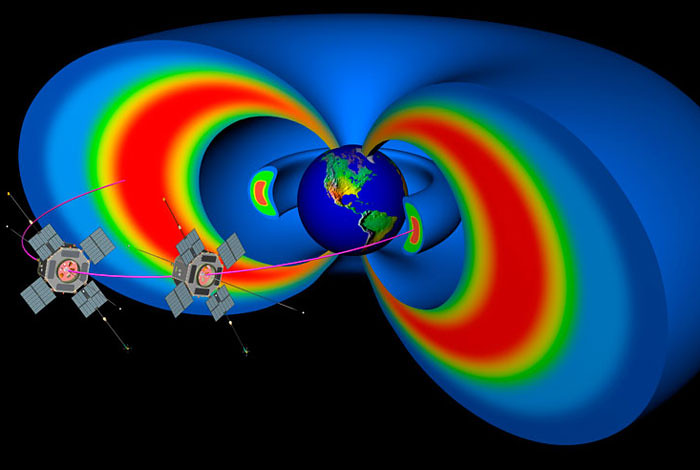

| Visitors Now: | |
| Total Visits: | |
| Total Stories: |

| Story Views | |
| Now: | |
| Last Hour: | |
| Last 24 Hours: | |
| Total: | |
Mysterious Electron Stash Found Hidden Among Van Allen Belts
U.S. researchers, including a trio from Los Alamos National Laboratory, have witnessed the mysterious appearance of a relatively long-lived zone of high-energy electrons stored between Earth’s Van Allen radiation belts.
The surprising findings, discovered by NASA’s Van Allen Probes (formerly known as the Radiation Belt Storm Probes), were outlined Thursday in Science Express and during a press conference at NASA headquarters in Washington, D.C. The research was led by Dan Baker of the University of Colorado, Boulder, Laboratory for Atmospheric and Space Physics.

“Nature keeps on surprising us by producing long-lived harsh environments in space in regions not previously considered,” said Los Alamos plasma physicist Reiner Friedel of LANL’s Intelligence and Space Research Division. “This finding may impact the planning of future space missions.”
The Van Allen radiation belts — named in honor James Van Allen, who discovered them nearly 50 years ago — are a pair of donut shaped zones of charged particles that surround Earth and occupy the inner region of our planet’s Magnetosphere. The outer belt contains extremely high-energy electrons, while the inner belt is comprised of energetic protons and electrons. The belts have been studied extensively since the dawn of the Space Age, because the high-energy particles in the outer ring can cripple or disrupt spacecraft. Long-term observation of the belts have hinted that the belts can act as efficient and powerful particle accelerators; the recent observations by the Van Allen Probes—a pair of spacecraft launched in August 2012—now seem to confirm this.
Shortly after launch, the spacecraft activated their Relativistic Electron-Proton Telescope (REPT) instruments to measure particles within the belts and their immediate environs. The instrument immediately detected on September 1, 2012, the presence of a stable zone of high-energy electrons residing between the belts. This donut-shaped third ring nestled between the belts existed for nearly a month before being obliterated by a powerful shockwave of particles emanating from center of the solar system.
Such a distinct, long-lasting ring of high-energy electrons had never before been seen by any prior instrument in space or on Earth. The findings suggest that the Van Allen Belts somehow capture and store energetic electrons in a circular path around our home planet, perhaps in much the same way as a cyclotron can capture and store charged particles here on Earth.
“One of the main reasons the Van Allen Probe instruments are seeing these new features are their unprecedented sensitivity and rejection of backgrounds,” Friedel said. “As the mission proceeds, we expect further surprises that will challenge our conventional wisdom on the transport, loss and energization processes in these highly energetic electron radiation regions.”
In addition to Friedel, Los Alamos research team members include Geoffrey D. Reeves and Michael G. Henderson. The research team is also represented by the Goddard Space Flight Center, University of New Hampshire, The Southwest Research Institute, Dartmouth College, the University of California—Los Angeles, University of Iowa, and The Aerospace Corporation.


